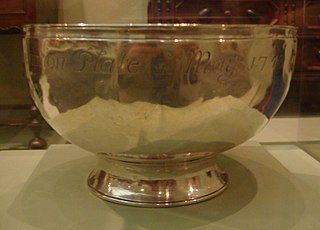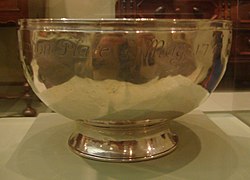
The Preakness Stakes is an American thoroughbred horse race held on Armed Forces Day which is also the third Saturday in May each year at Pimlico Race Course in Baltimore, Maryland. It is a Grade I race run over a distance of 9.5 furlongs on dirt. Colts and geldings carry 126 pounds (57 kg); fillies 121 pounds (55 kg). It is the second jewel of the Triple Crown, held two weeks after the Kentucky Derby and three weeks before the Belmont Stakes.

Oden Bowie, a member of the United States Democratic Party, was the 34th Governor of the State of Maryland in the United States from 1869 to 1872.

Pimlico Race Course is a thoroughbred horse racetrack in Baltimore, Maryland, most famous for hosting the Preakness Stakes. Its name is derived from the 1660s when English settlers named the area where the facility currently stands in honor of Olde Ben Pimlico's Tavern in London. The racetrack is nicknamed "Old Hilltop" after a small rise in the infield that became a favorite gathering place for thoroughbred trainers and race enthusiasts. It is currently owned by the Stronach Group.

The Woodlawn Vase is an American trophy given annually to the winning owner of the Preakness Stakes at Pimlico Race Course in Baltimore, Maryland.

Laurel Park, formerly Laurel Race Course, is an American thoroughbred racetrack located just outside Laurel, Maryland which opened in 1911. The track is 1+1⁄8 miles in circumference. Its name was changed to "Laurel Race Course" for several decades until returning to the "Laurel Park" designation in 1994.

The Dinner Party Stakes is an American Thoroughbred horse race held annually in mid-May at Pimlico Race Course in Baltimore, Maryland. It is the eighth-oldest graded stakes race in the United States and the oldest stakes race in Maryland and all of the Mid-Atlantic states. The race is open to horses age three and up and is run one and one-eighth miles on the turf. Currently a Grade II stakes race with a purse of $250,000, at one time the Dixie was a very important race that drew the top horses from across North America.

The George E. Mitchell Black-Eyed Susan Stakes is a Grade II American Thoroughbred horse race for three-year-old fillies run over a distance of 1+1⁄8 miles on the dirt annually at Pimlico Race Course in Baltimore, Maryland. The event currently offers a purse of $250,000
Milton Holbrook Sanford was an American businessman, lawyer, and owner/breeder of Thoroughbred racehorses.
Display (1923–1944) was an American Thoroughbred racehorse.

The Annapolis Subscription Plate is the name given both to the first recorded formal horse race in colonial Maryland and to the silver trophy awarded to the winner of the race. It is the second oldest known horse racing trophy in America.
Dungannon,, was a thoroughbred racehorse owned by the tobacco planter and horse breeder George Hume Steuart (1700–1784), who imported the horse from England to race against his rival, Charles Carroll of Annapolis (1703–1783). Dungannon won the Annapolis Subscription Plate, in May 1743, the first recorded formal horse race in colonial Maryland, and the second oldest in North America.
The Hilltop Stakes is an American ungraded Thoroughbred horse race for three-year-old fillies over a distance of one mile on turf held annually at Pimlico Race Course in Baltimore, Maryland.
Buskin was an American Thoroughbred racehorse is best known for winning the 1913 Preakness Stakes. Owned and trained by Mr. John Whalen, he was sired by Hamburg. Buskin was out of the mare Slippers, a daughter of Meddler.
Effendi was an American Thoroughbred racehorse is best known for winning the 1909 Preakness Stakes. Owned by Mr. W. T. Ryan, he was sired by Previous. Efendi was out of the mare Hatasoo, a daughter of Albert.
Don Enrique was an American Thoroughbred racehorse best known for winning the 1907 Preakness Stakes. Owned and bred by August Belmont Jr., he was sired by Hastings and out of the mare Bella Donna, a daughter of Hermit.
Old England (1899–1908) was an American Thoroughbred racehorse best known for winning the 1902 Preakness Stakes. Owned and trained by Green B. Morris, he was sired by Goldfinch. Old England was out of the mare Queen Bess, a daughter of Marden.
Linkage was an American Thoroughbred racehorse he was the son of Hoist the Flag and grandson to Tom Rolfe. Linkage will be best remembered for winning the 1982 Blue Grass Stakes and placing second five weeks later in the $200,000 grade 1 Preakness Stakes to Aloma's Ruler.
Eastern Fleet was an American Thoroughbred racehorse foaled on May 14, 1968. Bred by Calumet Farm and E. B. Benjamin, he was sired by Fleet Nasrullah and was a grandson of Nasrullah. He was out of a Bull Lea mare, Amoret. Eastern Fleet is best remembered for winning the grade 1 Florida Derby and finishing second in the $200,000 grade 1 Preakness Stakes to Canonero II.

Thoroughbred Racing on CBS is the de facto title for a series of horse races events whose broadcasts are produced by CBS Sports, the sports division of the CBS television network in the United States.
The Bowie Handicap at Pimlico Race Course in Baltimore, Maryland was a Thoroughbred horse race run between 1909 and 1938. A race on dirt, this once much anticipated event that drew some of the very best horses in the country was contested at distances from a mile and one-quarter to as much as two miles.










